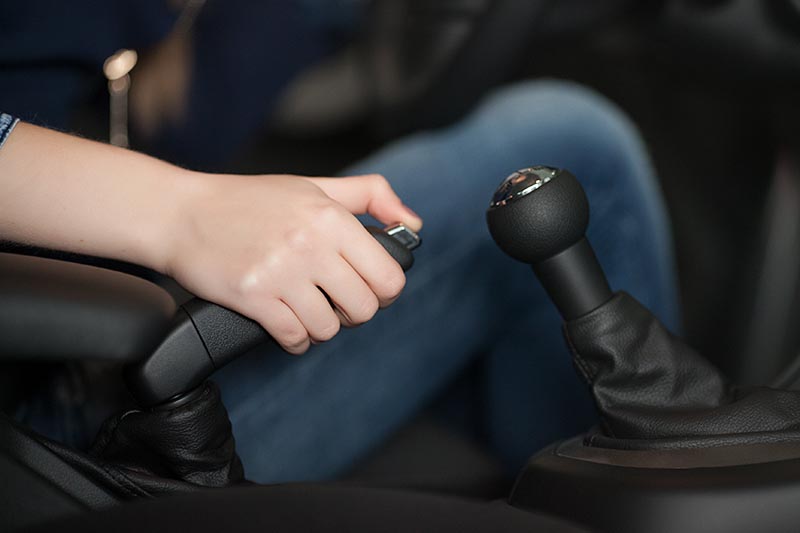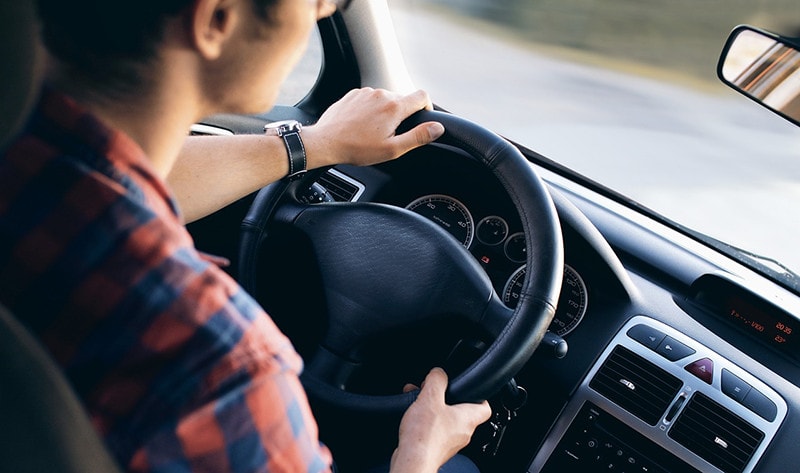How Does an Emergency Brake Work? Pros, Cons, Types, & FAQ
-
Pete Ortiz
- Last updated:

One of the most crucial components of any car is the braking system. Each car has two braking segments: the front brakes and the emergency brakes.
The emergency brake is an auxiliary brake that functions separately from the front hydraulic brakes. It can be a manual lever on the center console, a push-button on the dashboard, or a foot brake near the pedals. It is designed to keep your car motionless to allow you to regain control during extreme situations.
Dive in to learn more about the emergency brake. We will discuss how it works, when to use it, and more.
How Do Emergency Brakes Work?
The emergency brake is an important safety feature, also known as the parking brake, e-brake, or handbrake. It is a secondary braking system, separate from the primary hydraulic braking system, and is designed to bypass the hydraulic braking system in case of regular brake failure. Under state and federal laws, every car must have an emergency brake.
There are different types of e-brakes, although they all function pretty much the same.
The emergency braking mechanism is mechanical and functions through metallic cables and an intermediate lever. This is unless your car features the push-button parking brake. The metallic cables connect with the spring-operated lever at the rear brake calipers. When you apply the parking brake, the cables tighten and transmit the force needed to stop your car or prevent it from moving.
In vehicles with drum brakes on the rear wheels, engaging the parking brake pulls the cables that, in return, pull a lever that compresses the brake shoe to bring the car to a sudden halt.
The emergency brakes function slightly differently in vehicles with rear disc brakes. In this case, the cables engage a corkscrew device when you apply the parking brake. The corkscrew device pushes a piston into the brake pads to stop the vehicle.
If your car has a push-button parking brake, it will not have a cable mechanism. Instead, engaging the parking brake will trigger the motors at the rear wheels and lock them to bring the vehicle to a sudden halt.
What Are the Different Types of Emergency Brakes?
The three most common types of emergency brakes include the following.
1. Handbrake

The handbrake is also known as a center lever emergency brake. It is the most common type of emergency brake, and it features a lever that protrudes between the two front seats of a car. Pulling the lever up will automatically engage the emergency brake. To disengage it, find a button at the end of the lever, press it, and push down the lever to its original position.
2. Foot Brake
The foot brake is also called a foot pedal emergency braking system. It is a small pedal on the left side of the footwell.
To engage the foot brake, press it down until it clicks. To disengage it, pull the lever above the brake pedal and release it.
3. Push-Button Emergency Brake

Cars with an electric park brake system feature the push button emergency brake. It is the easiest to use, and the push button is conveniently located on the car’s console.
Push the button to apply the emergency brake and push it once more to disengage it.
When Should You Use Your Emergency Brake?
As awkward as it may sound, the emergency brakes should be used during more than “emergency” situations. It is good practice to use them daily to take off unnecessary pressure from the transmission. Using the emergency brake when parking also enhances security, ensuring your car cannot move once you are alight.
Here are other instances when you should engage the emergency brake.
1. When Hydraulic Brakes Fail
The emergency brake is mainly there for emergencies. It provides a backup system when the regular hydraulic brakes fail.
Modern cars’ braking systems have dual-circuit hydraulics and failsafe measures like low-fluid sensors and dashboard warning lights. While you are more likely to use your emergency brake as nothing more than a parking brake, it is crucial to know you can also engage it to save your life in extreme situations.

2. When Parking
The emergency brake is also called the parking brake because you should engage it when parking. Sometimes, you risk being slapped with a personal injury lawsuit or vehicle repair bill worth hundreds of dollars if your parked car moves even an inch. Applying the e-brakes ensures it cannot move from the parking spot.
Furthermore, engaging the e-brake can prevent your car from rolling when parked on a steep hill. Engaging the emergency brakes is beneficial even when parked on a flat surface. Besides providing an additional safety layer, using the brakes ensures they remain in excellent condition and work when you badly need them.
Another obvious instance when you should use your parking brake is when parked along a curb in close quarters. If your vehicle gets bumped in this event, engaging the parking brake may save your transmission from damage. Also, the brakes will ensure the vehicle remains stationary even when hit. This can prevent further damage to your car, nearby vehicles, or pedestrians.
3. During Regular Vehicle Maintenance
Engaging the e-brakes enhances the safety of the mechanics as they work on your car. Whether your mechanic is on a creeper under your vehicle or is changing a flat tire, it’s best to ensure the car cannot move. It is also good practice to apply emergency brakes when having your vehicle towed.
Whenever you use your parking brake, remember to release it before driving. While most cars will resist movement when the e-brake is engaged, others allow it with some notable levels of resistance. If you drive with the parking brake engaged, it will likely damage the brake components, which are expensive to repair.
- Reliable safety backup system
- Keep the car from rolling
- Takes off stress from the transmission
- Cables can rust if you rarely use the e-brakes
- Forgetting to disengage e-brakes can cause damage
Advantages of Electric Emergency Brakes

The traditional parking brake has a simple mechanism that works beautifully. Once you apply the brake, the cables pull the rear brake pads and bring your car to a stop. You can feel your rear wheels lock up and break out of traction.
Disadvantages of Electric Emergency Brakes
On the other hand, electric parking brakes are mainly automatic. One push of the button puts the transmission into “park” mode. Some systems even turn off automatically when you start your ride. There is no fun in engaging your e-brakes because a computer controls everything. Still, you enjoy enhanced safety, especially if you often forget to disengage the parking brakes.
Frequently Asked Questions (FAQs)
1. How Do I Keep My Emergency Brakes in a Pristine State?
E-brakes generally require little or no maintenance. A surefire way to keep them in great shape is to use them. The brakes automatically adjust whenever engaged, although you’ll need to get them cleaned occasionally. Periodic lubrication also helps to protect the cables from rust.
2. Can You Use Emergency Brakes as an Alternative to the Hydraulic Brake?
If your hydraulic brakes fail because of concerns like a fluid leak, you can use your emergency brakes. However, this should only be a temporary solution to allow you to pull over in a safe spot. Slowly apply the e-brake to regain control of your car. While at it, remember that e-brakes only control the rear brakes and exert one-third of the stopping power of your hydraulic brakes.
3. I Forgot to Disengage the E-brakes Before Driving! What Was That Burning Smell?
Riding with the emergency brakes engaged causes excessive friction between the rotors and the brake pads. The heat increases the temperature of the brake fluid to boiling point. This hot fluid can cause damage to components, causing your car to emit a burning odor. It is crucial to have your brakes inspected immediately.
Final Thoughts
The e-brake is an indispensable safety feature you should use daily. Now you know when, why, and how to apply your emergency brakes.
In a nutshell, applying the e-brakes can save your life if the regular brakes fail. Also, it can save you from a lawsuit caused by your car sliding out of its parking spot. Each time you apply the e-brakes, you relieve the transmissions of stress, enhance their longevity and prevent potentially expensive repairs!
Featured Image Credit: Photos box, Shutterstock
Contents





